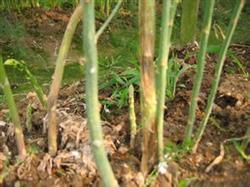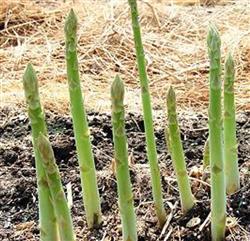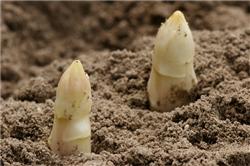Occurrence and control of common diseases of asparagus

Asparagus blight 1. Symptoms. Asparagus vertical blight, also known as Fusarium wilt, is a soil-borne disease. For the first time, individual plants in the field turned yellow and wilted, the whole plant withered after the disease spread, the tender stem became infected, the leaves and stems turned brown or split longitudinally, the underground stem and root of the diseased plant showed brown disease spot, the diseased part rotted in the later stage, white to pink mildew was produced, and the young bamboo shoots were infected with disease. the stem is small or cannot be unearthed. two。 Pathogen and route of transmission. The pathogen is asparagus specific type of Fusarium oxysporum. The pathogen overwinters in the soil with chlamydospores. The conidia produced in the following year were transmitted by Rain Water or irrigation water, and invaded through the wound to damage the stem and root system. After the disease, a large number of conidia were produced for re-infection, and the soil was too wet and easy to occur. 3. Prevention and control methods. The main results are as follows: (1) continuous cropping is not suitable for seedling cultivation, and rotation should be carried out for 3-4 years. (2) apply fully mature organic fertilizer, use special fertilizer for asparagus, and pay attention to prevent root burning or retting. (3) strengthen management, remove weeds in time, drain water in time after rain, reduce soil moisture and prevent moisture retention. (4) spray or irrigate 36% carbendazim 600 times solution or 50% carbendazim wettable powder 700 times solution, or 1purl 160 times Bordeaux solution at the initial stage of the disease, 77% can kill 500 times the wettable powder for prevention and treatment. 2. Asparagus root rot 1. Symptoms. It mainly harms the stem base or root, the initial disease turns brown, the cortex gradually decays, only the epidermis and vascular bundles remain, there are white mycelia under the epidermis, and in severe cases, the roots all rot, the roots fester, the plants yellowed, dwarf or withered, and generally do not fall leaves, which is different from vertical blight. two。 Pathogen and route of transmission. The pathogen is Fusarium oxysporum, which can survive on the seeds for 2 years. When the seeds germinate, conidia germinate and bud tubes grow, which invades the young roots from the wound. 3. The control methods are the same as asparagus blight, asparagus anthracnose. Symptoms. Mainly harms the stem, the disease spot on the stem is gray to light brown, fusiform or irregular, and there are small black spots in the later stage of the disease. two。 Pathogen and route of transmission. The pathogen is a subphylum of ascomycetes. The pathogen overwinters on the diseased remains with mycelium and conidia, and spreads by Rain Water from April to June of the following year. It expands rapidly in rainy season, and the incidence is mild in dry or dry years. 3. Prevention and control methods. The main results are as follows: (1) remove the diseased and disabled bodies in time during harvest and concentrate on burying or destroying them. (2) apply mature organic fertilizer. (3) during the onset period, pay attention to drainage after rain, strictly prevent flooding, watering should be arranged in the morning to reduce night dew. (4) spraying 500 times of 70% mancozeb wettable powder, 600 times of 75% chlorothalonil wettable powder and 800 times of 80% anthrax Fumei wettable powder at the initial stage of the disease, spraying I times at intervals of I0 days, continuous prevention and treatment for 2-3 times, and stopping the drug 7 days before harvest. 4. Asparagus stem rot 1. Symptoms. The main harm to young bamboo shoots, young bamboo shoots unearthed after the damage, the initial appearance of water-like spots on the stem surface, gradually expanded, then invaded the stem, stem tissue rot, aboveground wilt, high humidity can appear white mycelium in the stem surface tissue. two。 Pathogen and route of transmission. The pathogen is a kind of Pythium, which belongs to flagellum subphylum fungus. It overwinters with mycelium or sclerotia in the soil and can saprophyte for 2-3 years. The hyphae directly invade the host and spread through water flow and farm tools. The seeds are too dense and the humidity is high. 3. Prevention and control methods. The main results are as follows: (1) High border or ridging cultivation should not be too dense. (2) strengthen field management, drain water in time after rain, and reduce soil moisture. (3) timely removal of diseased bamboo shoots, concentrated deep burial or burning, so as to reduce the source of bacteria. (4) drip irrigation or under-film irrigation should be used to prevent flood irrigation. (5) at the initial stage of the disease, 75% ethyl phosphorus manganese zinc wettable powder was sprayed or irrigated with 75% ethyl phosphorus manganese zinc wettable powder or 64% antiseptic alum wettable powder, 72% DuPont Kelu wettable powder was sprayed or irrigated, and the drug was stopped 3 days before harvest. Asparagus mildew 1. Symptoms: the symptom of asparagus virus disease was not obvious in the field, the growth of the diseased plant was thin, curved and yellowed, and the yield decreased obviously. two。 Pathogen and route of transmission. The original asparagus virus No. 1, No. 2 and No. 3 were transmitted by seeds and juices, but not by aphids. 3. Prevention and control methods. (1) pay attention to the use of cutters during harvest and disinfect them if necessary to prevent the transmission of juice. (2) in order to prevent seed transmission, seeds should be collected from disease-free plants, and stem tip detoxification technology can be used if necessary. (3) at the initial stage of the disease, spray 20% Dukexin wettable powder 500-600 times or 0.5% antiviral agent I 300-350 times, 5% Shiduqing wettable powder 500 times, 20% virus Ling water-soluble powder 500 times, spray once every 7-10 days, spray 3 times in a row, stop 3 days before harvest.
- Prev

Asparagus pest control 14 points negative mud insect
It is widely distributed in China. It occurs 3-4 generations a year in Shandong and other places. It causes damage by eating young stems or epidermis of asparagus as adults and larvae. It can lead to abnormal shoot plants or eat them into bare ones, resulting in short and abnormal shoot plants or branches, pseudo-leaves clustering, serious dryness and death. The winter season is the season of winter...
- Next

Asparagus sowing and management after sowing
First, sowing time is to make use of the longest growing season, sowing as early as possible in spring. The sowing time should be 18 ℃ 20 min after the frost period. The higher the ground temperature, even up to 32 ℃, the faster the sprouting. Sowing too late in the growing season can lead to smaller mother plants. So if you sow too late in the growing season, do your best.
Related
- Where is it suitable to grow horseradish in China? it is expected to see the middle altitude horseradish in Alishan.
- How to prevent tomato virus disease reasonably? (Control methods included)
- Many people like to plant towel gourd on the balcony. What are the main points of this method and management?
- What crops can chili peppers be mixed with?
- Fertilization techniques and matters needing attention in Tomato
- What are the grafting techniques for peach seedlings in spring?
- Harm and control methods of root swelling disease of Chinese cabbage
- What are the pests of sweet potatoes? How to prevent and cure it?
- Symptoms, causes and Control methods of navel Rot in Tomato
- The cause of "Cucumber rotten bibcock" in Farmers' planting Cucumber and its Control Plan

